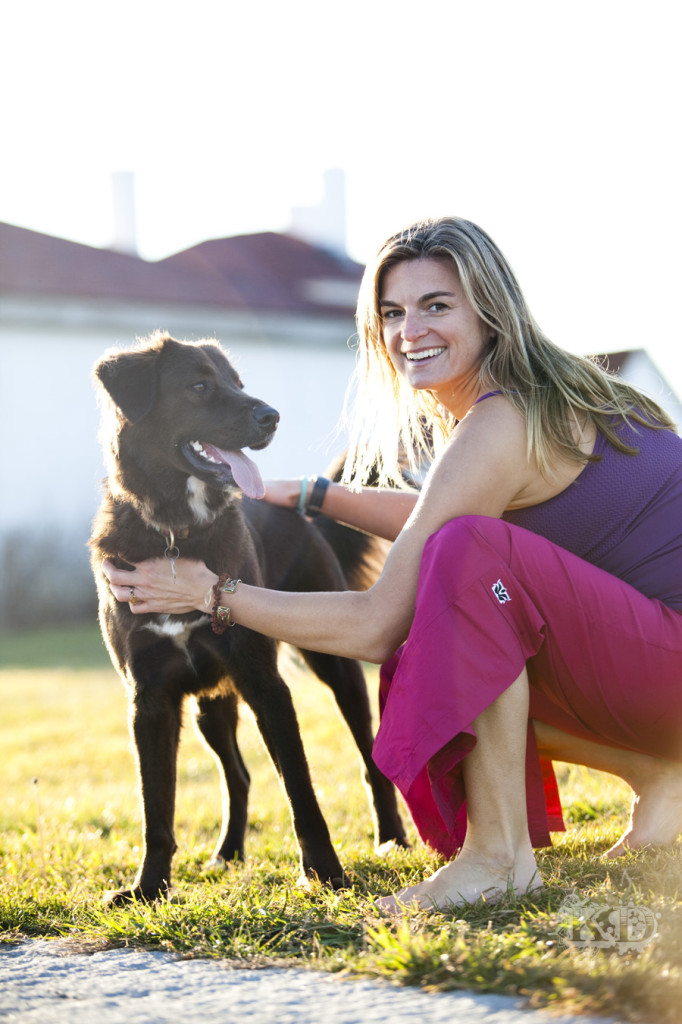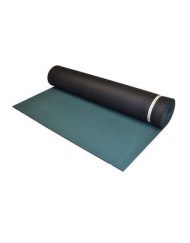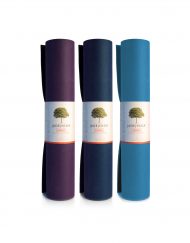Coral Brown – Power Source

Strengthening your core from the inside out lets you move—and live—from your center.
Surely there are no more-evocative words in the practice of yoga than these two: core strength. They point you to the vital force that holds you steady in your asana, keeps you upright in your standing poses, lends vitality in backbends, and enables you to maintain balance. Without a strong physical center, every pose you do is in danger of falling apart from the inside out. Core strength is what lets you keep it together.
However, that’s only half the story. “Core strength” also refers to the spiritual, ethical, and emotional essence of who you truly are. In the same way that your physical muscles hold you upright during practice, so, too, does this more subtle essence support your life. This kind of core strength gives you the power you need to act on what is in line with your innermost values—it can put you in touch with your dharma, the very purpose of your life. The whole point of practicing yoga is to become aware of what and where that core is and to be able to act from that center of your being. When you begin to engage the core with a multidimensional understanding, you’ll find that you can strengthen your back, abs, and thighs, and also your highest Self (yes, with a capital S). It takes effort and awareness, but yoga practice provides the opportunity to evolve. The core is where we start.
We have, in the West, an obsession with flat abs that is not all that helpful to our growth as humans—physically or spiritually. We like to work our abs hard and fast, often with the spirit of getting it over with. Western gym culture has promoted a fetish for rock-hard abs that has, unfortunately, spilled into every other area of life, including the yoga studio. As a result, many of us see our abdominal region as something that should be controlled or whipped into shape. We judge it by its appearance, and if it bulges out, we feel shame and want to hide it or work it harder, or both.

When you relate to your core this way, you create separation and suffering by shoring up the dualistic idea that you are separate from a part of yourself. This is the opposite of yoga.
Before you begin any practice of core strengthening, sit quietly for a moment to reflect. Invite yourself to explore your attitude toward the muscles of your physical core—your “abs,” if you will. Do you feel that they are strong or soft? Are you proud or ashamed of them? Do you approach them with an attitude of acceptance and kindness, or rigidity and rejection? What meaning do you attach to them? Who judges them? Be willing to acknowledge these thoughts and feelings about your core for exactly what they are—only thoughts and feelings, not universal truths.
Once you have a pretty good idea of how you view your core on a physical plane, consider it on a conceptual one. What do you consider to be your core values, beliefs, and strengths? What truths do you subscribe to? Do your speech and intentions align with these truths? Recognizing your core values can help you create a personal mission—or dharma—statement. Anytime you feel in your gut that something isn’t right, ask yourself if the situation aligns with your core values. If not, then maybe it’s not what you should pursue.
Whenever you undertake any asana or exercise intended to boost your core strength, take a moment to set an intention to practice in a way that honors your whole being—body, mind, and spirit—and nourishes your dharma, or your life’s purpose. Vinyasa, a common term used in yoga practice, has a very simple and profound translation. Vi means “with intention or in a special way”; nyasa means “to place.” This definition can remind you to place _ yourself mindfully and skillfully not only on the mat but in daily life, as well. Sometimes, taking just a moment or two to breathe and shine the light of awareness on the subtle core is enough to spark an inner revolution—and a completely new way of thinking about what it really means to have “great abs.”
Body Basics
Which is not to say that the physical doesn’t matter. In the practice of yoga asana, we make skillful use of the physical to turn the mind inward and upward, toward life’s larger themes (such as, what is my purpose?). To do that, we must shine the light of awareness on the muscles and bones of the body. In approaching core work, however, it can be hard to find common ground between the physical and spiritual.
Ask a roomful of yogis what the core is, and they’ll consider different criteria. But they’ll generally come up with some combination of back, legs, abdominals, and deep pelvic muscles. They are not wrong, of course—expert anatomists quibble among themselves on the precise definition. In fact, one could quite possibly make the argument that the core includes nearly every muscle in the body since they all stabilize us in one way or another.
For the sake of simplicity, we’ll focus on six key muscle groups. But let’s not just focus on what these muscles are. Let’s focus on what these muscles mean. The anatomical information for each group is here, along with a relevant affirmation for each—a way to go beyond the physical to the subtle. These are just suggestions. Use your own reflections to perfect them for your life.
1. Rectus Abdominis (RA)
The most external of the core muscles, the rectus abdominis, or RA, runs vertically from the middle of the rib cage in the front of the body to the pubic bone. It is, perhaps, the most obsessed-upon muscle in Western culture, as it is associated with “six-pack abs” (even though a cursory glance at an anatomical diagram reveals that they should really be called “ten-pack abs”—but, hey, who’s counting?). To engage it, you round the body forward in the classic exercise known as stomach crunches. Though the RA gets attention at the gym, it’s less of a focus in yoga, unless you’re doing Navasana (Boat Pose) or adding some kind of leg lifting or crunch-type exercises to your sequences. However, the RA does take center stage in the jump-backs and jump-throughs that are popular in Ashtanga Yoga sequences.
Affirmation: I can face any situation head on.
2. Obliques
The internal and external oblique abdominis muscles are more commonly known as the side muscles, and—as their name suggests—they run at a diagonal along the flank of the body, attaching to the midline beneath the RA. These are key players in the practice of yoga, as they’re essential for stabilizing the torso in lateral standing poses like Utthita Trikonasana (Extended Triangle Pose), Ardha Chandrasana (Half Moon Pose), and Utthita Parsvakonasana(Extended Side Angle Pose). One side engages as the other releases in every twisting pose.
Affirmation: Like a tree, I am flexible and strong.
3. Transverse Abdominis (TA)
Located below the obliques is the transverse abdominis (TA), a horizontal band of muscle that runs side-to-side from the rib cage to the pelvis and basically holds the contents of the abdomen in place. Its action is more subtle than that of the RA; it draws in toward the midline, applying gentle compression to the abdominal organs. I tell my students to think of it as a corset—or better yet, as shrink-wrap for the body. Pilates is a system of exercise that puts the TA front and center—the idea of “zipping up” the lower abdominals is a visualization of engaging the TA.
The TA is engaged in any pose that requires balance, and learning to activate it directly may help you avoid unskillful engagement of unrelated muscles such as the jaw or buttocks or toes. The TA is also directly related to—in fact, synonymous with—Uddiyana Bandha (Upward Abdominal Lock), which is a form of gentle abdominal contraction held throughout a vinyasa practice.
Affirmation: I am an integrated being.
4. Adductors
A general term, “adductors” is shorthand for a group of muscles that attach the thighbone to the pelvis. When these muscles contract, they bring the thighbone toward the midline of the body. They include the adductor brevis, adductor longus, adductor magnus, adductor minimus, gracilis, and pectineus.
If you are familiar with anatomical terms, you will already know that “adduction” means movement toward the sagittal plane of the body. But besides bringing the femur bones to the midline, in some poses the adductors assist in internal rotation (a.k.a., inner spiral). Many of us are in external rotation most of the time, something we reinforce with sitting and stair climbing. But as soon as you activate the inner thighs and begin to move them to the midline, you stabilize and activate the core. When you learn to engage and strengthen your adductors, you’ll likely notice that your inversions and arm balances become more stable.
Affirmation: I can find my roots in any situation.
5. Quadratus Lumborum (QL)
A deep stabilizing muscle that connects the upper and lower bodies, the quadratus lumborum (QL) runs more or less vertically from the lower ribs to the pelvic crest. It’s the key to good posture—both in a “stand up straight” sense and in a yoga asana sense. The QL is responsible for setting hip height and can deeply influence the curvature of the lower spine—in a negative way when it’s overly contracted or unbalanced. The muscle is also intimately linked to the breath, allowing (or restricting, as the case may be) the full expansion of the diaphragm. Like the obliques, the muscle is a key player in sidebends, lateral standing poses, and twists, but it is deeper in the body (beneath a layer of superficial back muscles called the erector spinea), making it a little harder to feel.
Affirmation: I am on strong ground.
6. Psoas Major
The deepest of the core muscles is the psoas major. It originates at the outside of every lumbar vertebra, travels across the pelvis in front of the pubic bone, and attaches to the inner thighbone. It is a hip flexor—a large and very strong muscle that most of us use unconsciously. We use the psoas when we walk, stand, and sit; we don’t have to think about it. To put it in yoga terms, we flex it in Navasana, and we extend it in Supta Virasana (Reclining Hero Pose).
Beyond that, it is one of the most reactive muscles in the body. In a very literal sense, the psoas is all about protection—it is the muscle we use to curl the legs into the body when we need to ball up to protect the internal organs from some threat, real or perceived. For many of us, the psoas is habitually tight on one or both sides, leading to an interesting range of body imbalances.
Affirmation: I am deeply supported by life.
Finding the Middle
Knowing what the names of these muscles are, where they are, and what they do is helpful information only if you use it in the service of enlightening your practice. Don’t just file it away—put it into practice in our Strong Core program.
The Strong Core program will help you let go of superficial attitudes about core strength and embrace a multidimensional approach that encompasses all aspects of your being. Some of the moves will look familiar; others will seem entirely new.
All the poses allow for both relaxation and exertion. Many—such as the Forearm Plank Pose—involve a tiny pulsation designed to encourage lengthening and strengthening. As we engage the muscles to move deeper into the pose, we use the sympathetic nervous system skillfully. As we gently and subtly relax, we allow the calming parasympathetic nervous system to come online.
Core work can’t be complete when it’s focused utterly on contraction at the expense of expansion. This is true for muscles and for the Self. To be anchored in “who we are,” we must find a firm middle ground—that magical balance between sthira (steadiness) and sukha (ease).
As practitioners of yoga, we have a responsibility to evolve. Asana is a gift in that it lets us do just that. True core strength is about embodying your purpose, not just on the mat but in your life. It is about being strong and capable in the world, so that you are empowered to do what you are here to do.
Get Centered: Sequence by Coral Brown
Forearm Side Plank Pose

This side-waist strengthening pose will remind you to activate your core to facilitate balance. Much like the related pose Vasisthasana (Side Plank Pose), this variation challenges you to remain in your center.
Begin by lying on your side with your elbow directly under your shoulder. Place the opposite hand on the floor in front of the navel for support, and stack your feet. Firmly press into the forearm, palm, and feet while extending through your legs to elevate your hips. Cinch the bottom side-waist, and reach your opposite arm strongly toward the ceiling to avoid collapsing your bottom shoulder. Maintain alignment between the crown of the head, the hips, and the arches of the feet. To increase the intensity of this pose, lower and lift your pelvis.
Sphinx Roll-Up

This asana helps connect you to the deep layers of your core. Once you learn how to access these muscles, you will feel more stable and fluid in many asanas and in transitions, such as lifting from Urdhva Mukha Svanasana (Upward-Facing Dog Pose) to Adho Mukha Svanasana(Downward-Facing Dog Pose).
Begin in Sphinx Pose, rooting into your forearms, palms, and tops of the feet. Radiate muscular engagement throughout your legs, creating equal awareness of the big-toe and little-toe sides of the feet. Tuck your tailbone, and notice how your low belly engages. Bow your head toward your heart as you start to peel the belly, pubic bone, and thighs off the floor. Lifting through your low belly, round the upper back and push firmly into your index fingers, thumbs, and the tops of your feet. Stay for 3 to 5 breaths; roll back down and repeat.
Forearm Plank Pose

This asana creates awareness of how the core supports the whole body. It will prepare you for backbending asanas by reminding you to initiate movement and support from all of the core muscles, including the muscles in the belly, back, and legs.
Begin in Sphinx Pose with your toes curled under. Tuck your tailbone. Press down through your forearms. Peel your belly, hips, and thighs off the ground. Strongly radiate energy through your heels to activate and lift your legs. Continue to lengthen your tailbone toward your heels while drawing your navel toward the spine. Pull your shoulder blades away from each other to avoid collapsing your chest. Soften your face, and slow down your breath.
To further your core awareness, try several pulsations: Inhale, round your upper back while increasing the tuck of your tailbone, and gaze toward the toes. Exhale, release the tuck, lengthen your spine, and gaze at the fingertips.
Staff Pose (Dandasana), variation

In this version of Dandasana (Staff Pose), you’ll place a block between your thighs to feel the inner legs activate. Connecting with this sensation will give you stability in standing balance poses and in arm balances, inversions, and jump-throughs and jump-backs.
Sit in Dandasana with a block placed between your inner thighs. Lengthen your spine, lift your chest, and raise your pelvic floor. Actively reach through your legs. Draw your toes toward your face as you press through the balls of your feet. Place your palms on the ground about halfway between your hips and knees. Begin to push into your hands, squeeze the block, and draw your hips up and back. Your upper back will round as your lower belly lifts up and back toward the spine. You can keep your heels on the floor or lift them for a deeper sensation. Hover for 2 to 3 breaths and release. To make this asana a little more accessible, try using a block under each hand.
Reclining Crane Pose (Supta Bakasana)

The supine variation of Bakasana (Crane Pose) demonstrates the level of core awareness and activation required in arm balances. It also builds confidence, since Bakasana is much more accessible when you remove the possibility of falling!
Begin in Supta Baddha Konasana (Reclining Bound Angle Pose). Push your low belly toward the spine, and keep your hips open while drawing your knees toward your shoulders. Touch your big toes together, and drop your heels toward your tailbone. Lift your upper body, and extend your arms over the shins. Push through your palms as though you were standing on your hands. Continue to lift your shoulder blades off the ground while squeezing your legs into your upper arms and pushing your arms into your legs. Push your lower belly down, bring your knees closer to your shoulders, extend your hands past your feet, and then release.
Revolved Abdomen Pose (Jathara Parivartanasana), variation

This hovering variation of the supine twist brings attention to the side-waist muscles, particularly the obliques and the quadratus lumborum.
Recline on your mat with your knees bent and feet on the floor. Extend your arms out on the floor, making a T shape, palms turned down. Lift your knees, and stack them over your hips, shins parallel to the floor. Pull your knees slightly toward your chest, engaging your low belly and creating a seal between your lower back and the floor. Gaze toward your right hand, and begin to lower your legs to the left, stopping as soon as your right shoulder begins to lift off the ground. Pause here, and press actively into your right hand. Keep your legs active, and imagine pushing your right lower ribs toward the mat. Relax your jaw, and soften your face and neck. To release, push your navel toward your spine and slowly bring your legs back to center. Repeat on the other side. To deepen this pose, try straightening your legs as you twist.
Coral Brown teaches PranaFlow Yoga, has a master’s degree in holistic counseling, and leads workshops, retreats, and trainings worldwide. Hillari Dowdle is a contributing editor for Yoga Journal.
Article source: http://www.yogajournal.com/practice/2878












